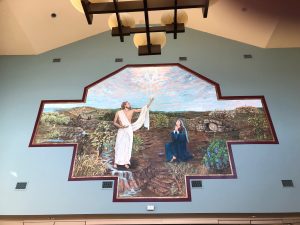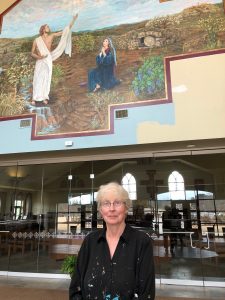
In 2017 Father Terry said he wanted a mural to be painted on the wall above the glass doors in the narthex. He described a scene with an open tomb, the stone rolled away, and the resurrected Jesus telling Mary Magdalene, “Do not touch me, as I have not gone to the Father.” I said I could paint the scene, but asked how I was going to get up to the wall? Father Terry said to let him worry about that.
Work started with the shape of the mural and figures, which were designed to fit the style of the church. Several small-scale drawings were made. As the first drawings of the mural progressed, Father Terry suggested some details: a few of the apostles, the city of Jerusalem, and Golgotha with the three crosses. The internet has a wealth of information, including pictures that show how other artists have interpreted this scene, but the church needed its own interpretation.
Beginning in May of 2017, the shape of the mural reflected the arched shape of the windows. It was later changed into a dome shape, and by October, the mural took the shape of the San Damiano cross found above the altar. The size and shape of the mural and the size of the figures of Jesus and Mary Magdalene were calculated using church blueprints of the wall.
The design was ready, but the wall was not. The plaster cracks needed repairing, and the wall needed priming, as it had not been repainted since the church was built. After research and sketching preliminary drawings, a small-scale chalk sketch of the mural with the poses of the two figures was drawn in February of 2017. With a few adjustments for perspective and to avoid the chandelier blocking the view from the ground, in May of 2018, Johnny Holloway taped off the mural shape of the San Damiano cross. He repaired the cracks in the plaster and primed the wall in the shape of the cross using four background colors. Father Terry rented a lift and harness. Painting was underway.
Research continued even though drawing and painting had begun. Additional information about the time of Jesus helped with the design and painting of the appropriate plants and flowers, birds, clothing, old Jerusalem, Golgotha, the Mount of Olives, gardens with tombs, the topography and soil of Israel, the size and shape of the shroud of Turin, and the sky at dawn.
The decision regarding the faces and poses of Mary Magdalene and Jesus were the most difficult. An acquaintance who had posed for a past project matched the direction of the pose for Jesus. But he had passed, and I couldn’t talk to him about the project. His face became the model for the face of Jesus. He was a carpenter. The first choice for the face of Mary Magdalene was a doctor at Emory Hospital in Atlanta. But plans changed when we found a random photo of a woman with a startled expression and the right pose of hands. Eventually, the original face won out, but the hands stayed. Two other people agreed to be models for the drawing of the bodies of Jesus and Mary Magdalene. Jesus is clothed in a replica of the Shroud of Turin. A soft cloth the size and shape as the shroud was given to the model for Jesus, with the directions, “How would a man put on this cloth?”
The final small-scale figures of Mary Magdalene and Jesus were drawn, and in June of 2018, they were projected onto five feet by five feet sheets of cloth donated by Linda Porter. Using the big glass doors of the narthex with the sun shining through, the cloth was turned over and the figures were traced with chalk, on the back of the large squares. After Vince Antonich gave several lessons on how to go up and down in the lift, Vince drove it into place and the painting could finally begin. The cloth was flipped to the front side, taped to the wall, and the figures were traced again. The chalk on the back side of the cloth transferred the drawings to the wall. Adjustments were needed for perspective, figures were redrawn, and painting on the wall started in July of 2018.
The figure of Mary Magdalene was painted first with the random face. Then the morning sky and the dove representing the Holy Spirit were painted. The shape of the Holy Spirit needed to be something unique to Mary Magdalene Church. The dove shape was found in an unusual place. The shape of a dove had formed in the moisture inside the arched double paned glass above the doors at the entrance to the church. The shape was not only unique but was also a part of Mary Magdalene.
The outer shape of the mural evolved out of necessity. The San Damiano cross shape came too close to the head of Jesus. Father Terry solved the problem. He suggested a Greek cross shape and drew the adjustment to the San Damiano cross. That became the final shape of the mural.
Once the sky, Holy Spirit, and Mary Magdalene had been painted, it was time to add many of the background details, including the wall around Joseph of Arimathea’s garden and appropriate vegetation. Also, the face of Mary Magdalene was changed back to the original model. Bit by bit the mural progressed. In September of 2018, Golgotha, the tomb, and the old city of Jerusalem were painted. As research continued and new information came in, Jerusalem was repainted several times. Also painting of the face and figure of Jesus began.
Parishioners and visitors coming and going through the church gave advice, suggestions, opinions, observations, ideas, and help with decisions. Their input was greatly appreciated and helped determine many aspects of the mural. For example, when a balance of color to compliment the large area of blue sky was needed, Kathy Kelly Huey suggested a spring of water, because Jesus is the water of life. This addition balanced the color and fit with the narrative of the earthquake that rolled back the stone. The earthquake started a spring of water from the rock wall behind the figure of Jesus. Mayra Marchand printed out the scriptures with references of the scene as told in the books of the Bible. The poses of the apostles Peter, James, and John coming out of the Mount of Olives were made possible because a visitor to the church agreed to run across the narthex. David Smith, who had been to the Holy Land, gave input for the shape of Golgotha, the acacia trees, and printed out pictures of the plants from the time of Jesus.
The trees on the mural were growing in Jesus’s time: frankincense, myrrh, apricot, acacia, date palm, olive, and citron. They are blooming to represent the time of year, Spring, as are the iris, day lilies, cornflower, and flax. The ripe wheat and grapes symbolize the Eucharist. The bright white clouds at the top of the mural represent God the Father with rays of light pouring God’s grace down on Jesus. The Holy Spirit completes the Trinity.
The border for the mural was started in November of 2018. The color of the border was painted to match the color of the windows and door frames found in the church. Final corrections and the addition of little birds and flowers were made in December. Vince painted the wall surrounding the mural with a color to complement the colors of the mural. Vince gave great advice, many ideas, and without his help driving the lift, the mural would not have been completed. While the actual painting took six months, the research, ideas, composition, drawings, painting, and border took about 18 months. I am honored that Father Terry asked me to paint his vision of a mural for Mary Magdalene Church. I have thoroughly enjoyed painting it. Thank you to Father Terry and Vince, and all the people who listened and gave advice. I couldn’t have done it without you.
Cecilia Smith

